
Scandinavia is a subregion of Northern Europe, with strong historical, cultural, and linguistic ties between its constituent peoples. Scandinavia most commonly refers to Denmark, Norway, and Sweden. It can sometimes also refer to the Scandinavian Peninsula. In English usage, Scandinavia is sometimes used as a synonym for Nordic countries. Iceland and the Faroe Islands are sometimes included in Scandinavia for their ethnolinguistic relations with Sweden, Norway and Denmark. While Finland differs from other Nordic countries in this respect, some authors call it Scandinavian due to its economic and cultural similarities.

Lithuanian Brazilians are Brazilian citizens who are fully, partially or predominantly of Lithuanian descent or are Lithuanian-born people residing in Brazil.

The South Region of Brazil is one of the five regions of Brazil. It includes the states of Paraná, Rio Grande do Sul, and Santa Catarina, and covers 576,409.6 square kilometres (222,553.0 sq mi), being the smallest region of the country, occupying only about 6.76% of the territory of Brazil. Its whole area is smaller than that of the state of Minas Gerais, in Southeast Brazil, for example or the whole metropolitan France.
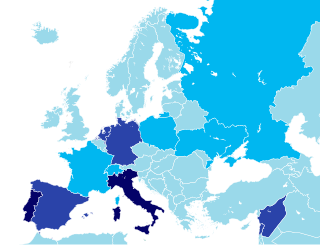
Immigration to Brazil is the movement to Brazil of foreign peoples to reside permanently. It should not be confused with the forcible bringing of people from Africa as slaves. Latin Europe accounted for four-fifths of the arrivals. This engendered a strikingly multicultural society. Yet over a few generations, Brazil absorbed these new populations in a manner that resembles the experience of the rest of the New World.

Alandroal is a municipality in the Portuguese district of Évora located on the eastern frontier with Spain along the right margin of the Guadiana River in the Central Alentejo region. It is located 341 metres (1,119 ft) above sea level, northeast of Évora and southeast of Estremoz. The population in 2011 was 5,843, in an area of 542.68 km².
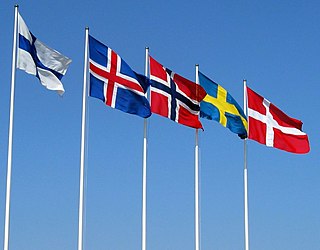
A Nordic cross flag is a flag bearing the design of the Nordic or Scandinavian cross, a cross symbol in a rectangular field, with the centre of the cross shifted towards the hoist.

São Cristóvão is a Brazilian municipality in the Northeastern state of Sergipe. Founded at the mouth of the Vaza-Barris River on January 1, 1590, the municipality is the fourth oldest settlement in Brazil. São Cristóvão is noted for its historic city square, São Francisco Square, and numerous early colonial-period buildings. The 3 hectares site was designated a UNESCO World Heritage Site in 2010.

Santo Ângelo is a municipality located in northwestern Rio Grande do Sul state, Brazil. It has about 77,568 inhabitants and the total area of the municipality is about 679 km². It borders Giruá to the north, and Entre-Ijuís to the south—it's linked to Santo Ângelo by the state road RS 344. The city is located 443 km (275 mi) from the state capital, Porto Alegre.
Nordic and Scandinavian Americans are Americans of Scandinavian and/or Nordic ancestry, including Danish Americans, Faroese Americans, Finnish Americans, Greenlandic Americans, Icelandic Americans, Norwegian Americans, and Swedish Americans. Also included are persons who reported 'Scandinavian' ancestry on their census. According to 2021 census estimates, there are approximately 9,365,489 people of Scandinavian ancestry in the United States.

Polish Brazilians refers to Brazilians of full or partial Polish ancestry who are aware of such ancestry and remain connected, to some degree, to Polish culture, or Polish-born people permanently residing in Brazil. Also, a Polish Brazilian may have one Polish parent.
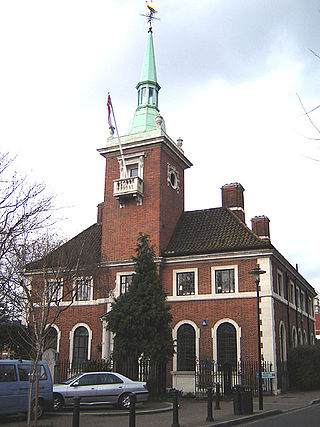
The Norwegian Church Abroad or The Norwegian Seamen’s Church is a religious organisation serving Norwegians and other Scandinavians travelling abroad. Founded in 1864, The Norwegian Seamen's Mission – Sjømannsmisjonen – was established to secure the moral and religious education of Scandinavian seafarers, but also to give them a "breathing room" where a fellow countryman was available to lend an ear and give some attention. The churches and their staff together with travelling pastors around the globe represent a "resource center" for all Norwegians travelling internationally.
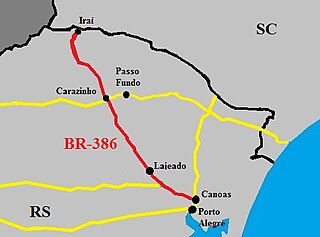
The BR-386 is a Brazilian federal highway running between the southern states of Rio Grande do Sul and Santa Catarina. It has a total length of 525 km (326 mi).
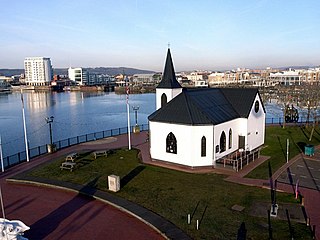
The Norwegian Church Arts Centre is a point of cultural and historical interest located in Cardiff Bay, Wales. It was a Lutheran Church, consecrated in 1868. Under the patronage of The Norwegian Seamen's Mission it provided home comforts, communication with family and a place of worship for Scandinavian sailors and the Norwegian community in Cardiff for over a hundred years.

White Brazilians refers to Brazilian citizens who are considered or self-identify as "white", typically because of European or West Asian ancestry from Lebanon and Syria.
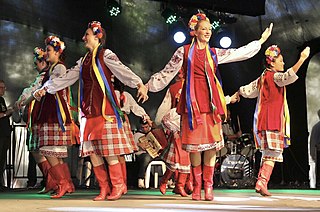
Czech Brazilians refer to Brazilians of Czech descent who were born in or who trace their ancestry to the territory of the historic Czech lands or succession states, now known as the Czech Republic, and are residents and/or citizens of Brazil.
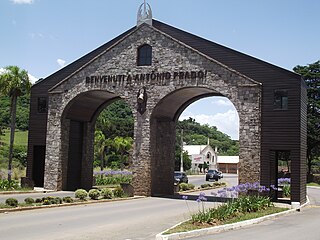
Antônio Prado is a municipality located in the Serra Gaúcha regionin The city is situated in the state of Rio Grande do Sul, Brazil. It boasts the largest collection of architectural heritage designated by IPHAN related to Italian colonization in Brazil. Its population is estimated at 13,041 people.

The Presbyterian Church of Brazil is an Evangelical Protestant Christian denomination in Brazil. It is the largest Presbyterian denomination in the country, having an estimate 702,949 members, 4,915 ordained ministers and 5,420 churches and parishes. It is also the only Presbyterian denomination in Brazil present in all 26 States and the Federal District.

Snow in Brazil occurs yearly in the high plains of the country's South Region. Elsewhere in the country it is a rare phenomenon but has been registered several times.
The Nordic diaspora may refer to:

Martine Soffiatti Grael is a Brazilian sailor in the 49er FX class. Together with Kahena Kunze she won the 49er FX class at the 2014 ISAF Sailing World Championships and at the 2016 Rio Olympics, and 2020 Tokyo Olympics.























